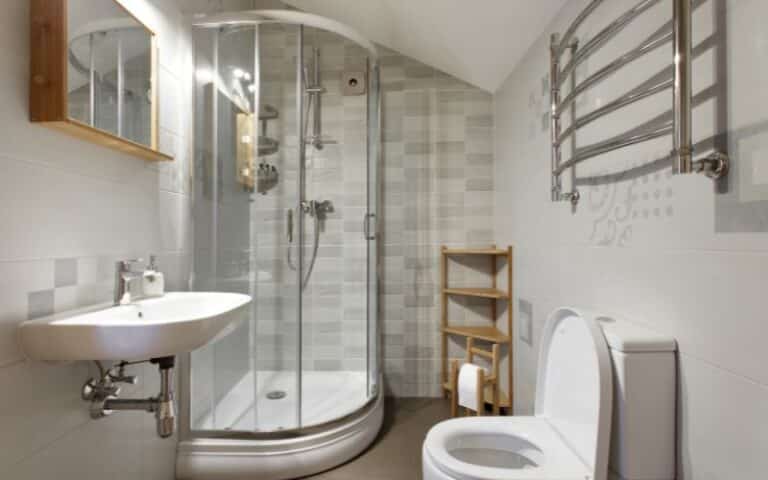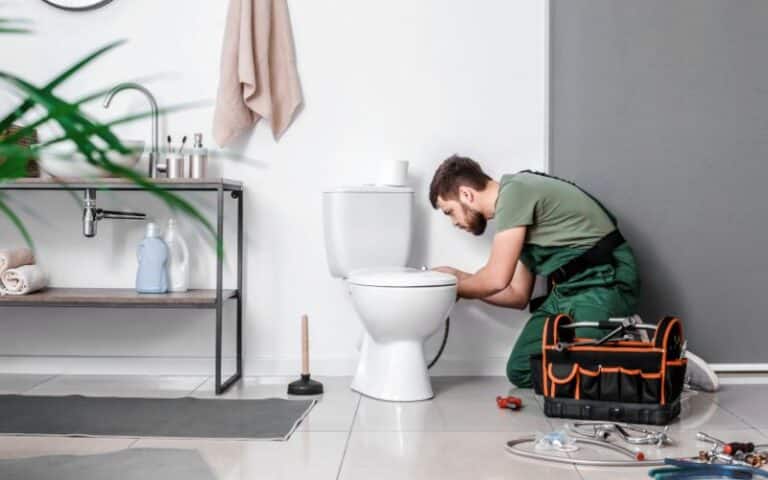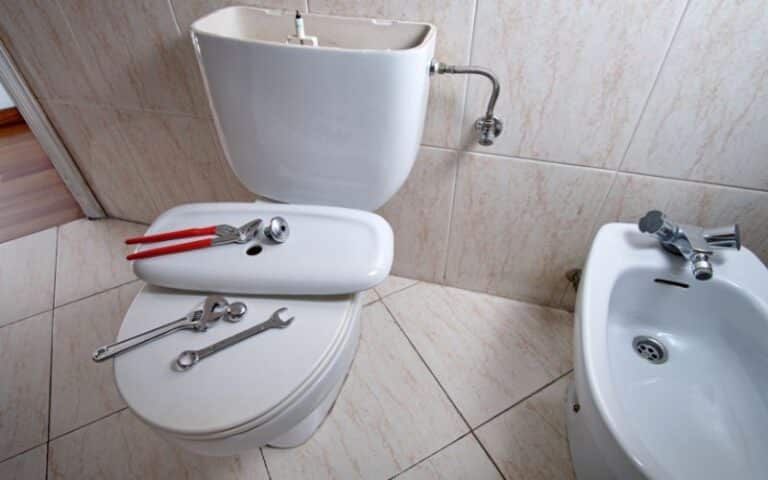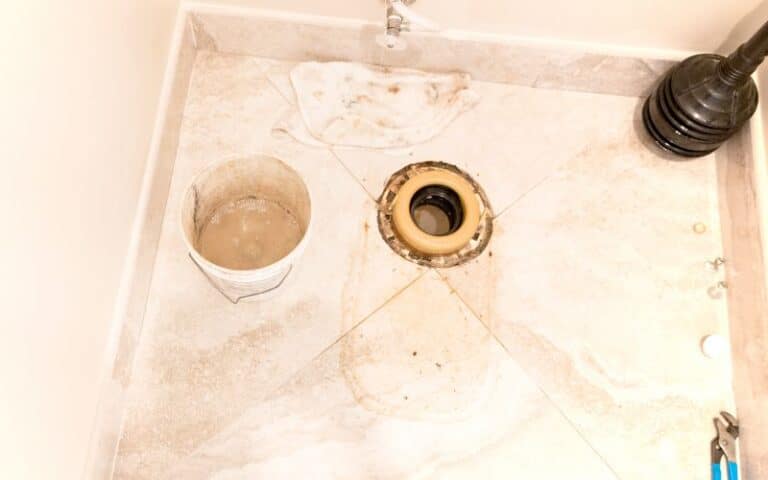Toilet splashes when flushing can be both an inconvenience and a hygiene concern.
While this issue may be trivial to some, toilet splash has implications for hygiene and cleanliness.
Dealing with toilet water splashes can be uncomfortable and unpleasant, leading to a negative restroom experience.
Thus, understanding the reasons behind this issue and knowing how to tackle it is essential for maintaining a clean and comfortable bathroom experience.
Therefore, what causes toilets to splash when flushed?
Many things can cause your toilet to splash whenever you flush it, and among them are water volume and pressure, water level, faulty flapper valve, and obstruction in the toilet’s trapway. Moreover, the impact angle and the toilet bowl shape can also cause a splash when flushing. The solution to a toilet splash depends on its exact cause.
In this article, I will reveal why toilets splash upon flushing and provide practical solutions to prevent this issue.
By the end, you will know how to maintain a cleaner and more hygienic toilet.
5 Reasons Why Toilet Splash When Flushed with Solutions
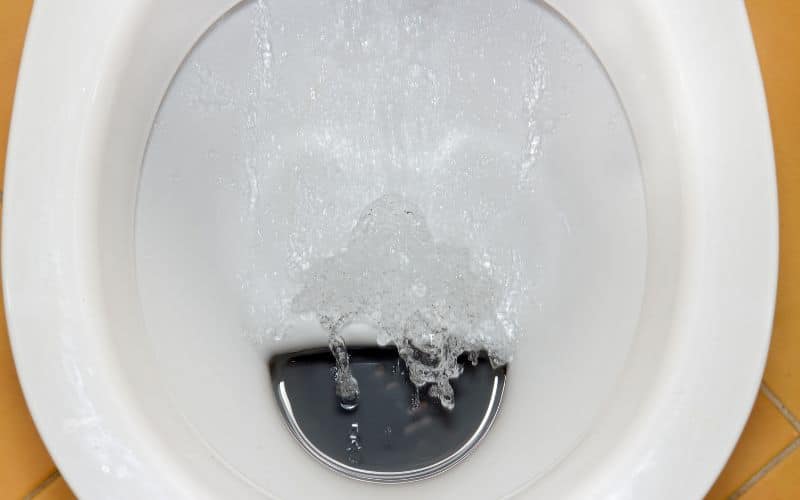
A toilet splash occurs due to the rapid expulsion of water, causing droplets to rise and escape the toilet bowl, leading to a splash.
Several reasons contribute to this issue, and here are they:
#1. Water Volume and Pressure
The design of toilets is always in such a way that creates a forceful flush to remove waste efficiently.
High water volume and pressure are necessary for this purpose but can also lead to splashes.
The sudden rush of water creates turbulence, causing small droplets to splash out of the bowl.
Older toilets with larger water tanks often release significant water quickly, causing a splash. So you should change your toilet when old.
#2. Bowl Shape
The shape of the toilet bowl plays a crucial role in splash formation. Toilet bowls with an improper shape or design can contribute to splashes.
The angle at which the water enters the bowl and the presence of flat surfaces can cause water to rebound and splash.
Some bowl designs have steeper angles, which can cause water to hit the bowl’s sides, which results in splashes. So watch out for bowl shape when purchasing toilets.
#3. Water Level
An incorrect water level in the toilet bowl can contribute to splashes. If the water level is too high, there’s less space for waste to drop without causing splashes.
High water levels in the bowl can also cause the water to overflow when flushing and create splashes.
In addition, low water levels can result in incomplete waste removal and splashing during flushing. So, ensure the water level is adequate before using the loo.
#4. Obstructions in the Trapway
Blockages or partial clogs in the trapway (the curved channel in the toilet) can disrupt the water flow and lead to splashing as the water encounters resistance.
For instance, debris, such as toilet paper or other foreign objects, can disrupt water flow during flushing and lead to splashes. Therefore, you should avoid flushing foreign objects.
#5. Faulty Flapper Valve
Another thing that can cause your toilet to splash when flushing is a faulty flapper valve.
A malfunctioning flapper valve can cause an inconsistent flush, resulting in insufficient water flow during a flush, leading to splashes. Luckily, you can repair or replace the valve.
Does Kohler Toilet Splash When Flushed?
When flushing, Toilet splashes often depend on individual usage habits and factors, such as malfunctioning flapper valves, water volume, force, water level, obstructions in the trap way, etc.
So, whether or not your Kohler toilet will splash when flushing depends on these factors.
Kohler, a well-known brand in bathroom fixtures, offers a range of toilet models with varying features.
Some Kohler toilet designs have advanced flushing technologies that aim to minimize splashing.
These technologies often include optimized water flow, strategically positioned jets, and improved bowl geometry.
Several Kohler toilet models incorporate innovative technologies to reduce splashing. For instance, some models feature AquaPiston technology.
This technology uses a canister design to release water into the bowl from all sides, helping to enhance flushing effectiveness while minimizing splashing.
In addition, Kohler’s Class Five and Class Six flushing systems can generate strong water flow for efficient waste removal, reducing splashing.
In essence, regardless of your toilet’s brand, by understanding the causes of toilet splashing and following maintenance tips, you can have a cleaner and more hygienic bathroom experience.
Does Briggs Toilet Splash When Flushed?
Briggs toilets, like any other toilet, can create splashes during a flush.
It’s important to note that various factors influence toilet splash when flushing, including water pressure, tramway design, and bowl shape.
For instance, the water pressure during a flush significantly determines whether a toilet will produce splashes.
Therefore, some toilets, regardless of the brand, can create splashes if the water pressure is too high.
Briggs is a reputable brand known for producing a variety of plumbing fixtures, including toilets.
Briggs toilets incorporate intricate engineering to ensure efficient and hygienic waste disposal.
This engineering involves a combination of water pressure, tramway design, and bowl shape.
Therefore, the conclusion on whether Briggs toilets splash when flushed greatly lies in individual experiences, as individual experiences can vary based on different factors.
How To Prevent Toilet From Splashing When Flushed?
Thankfully, there are simple and effective ways to prevent toilets from splashing when flushed, ensuring a cleaner and more pleasant bathroom experience.
However, the first thing to note when finding effective solutions to your toilet that splashes when flushed is to determine the exact cause of the splash.
Finding the exact cause is necessary because various reasons cause a toilet splash.
Regardless of the cause of your toilet splash, one or a combination of two or more solutions below will correct the issue.
#1. Adjust the Water Level
One of the primary factors contributing to toilet splash is the water level in the bowl. In a situation where the water level is too high, the force of the flush can lead to splashing.
Most toilets have a water level adjustment mechanism, often in the form of a float or fill valve.
By reducing the water level slightly, you can minimize the impact and reduce the likelihood of splashes.
#2. Use a Toilet Lid
The toilet lid is more than just a cover; it is a barrier to any splashes that might occur during flushing.
Closing the lid before flushing can significantly reduce the chances of water splashing out of the bowl.
In addition, it’s a good practice to keep the lid closed when the toilet is not in use to prevent the spread of germs and maintain a tidy appearance.
#3. Flush Gently
The force of the flush contributes to the water’s movement in the bowl.
Flushing the toilet gently, rather than forcefully, can help minimize the water’s agitation and reduce the likelihood of splashes.
Most modern toilets have a dual-flush feature, which allows you to control the water volume based on the type of waste you are flushing.
#4. Get a Toilet with a Good Bowl Shape
Consider investing in a toilet with a bowl design that minimizes splashes.
A wider, more gently sloping bowl design can help prevent water from splashing back.
Adding a toilet liner or non-stick coating can also help reduce splashes.
#5. Maintain Proper Toilet Hygiene
Regular toilet maintenance can also contribute to preventing splashes. Ensure the toilet’s internal components are functioning properly.
A malfunctioning flapper or fill valve can lead to irregular water flow, increasing the chances of splashing.
If you notice any of these internal components are malfunctioning, repair or replace them.
Regularly cleaning the bowl and the jet holes around the rim will also help maintain optimal flushing performance.
In addition, ensure that you only flush appropriate materials down your toilet to prevent clogging.
Proper disposal of waste and using toilet paper that disintegrates easily can prevent blockages and splashes.
As insignificant as the issue of toilet splash when flushing can be to some, preventing it or finding solutions can make a lot of difference to your overall bathroom experience.
The table below highlights the significant differences between a toilet that splashes when flushing and a normal toilet.
| Splashing Toilet | Normal Toilet |
|---|---|
| It brings about hygiene concerns, spreading harmful bacteria and germs around. | Normal toilets improve hygiene and minimize the spread of germs. |
| It leads to an unpleasant restroom experience. | It improves the restroom experience. |
| Splashes can release unpleasant odors, making the environment less inviting. | Normal toilets reduce odor dispersal. |
| Frequent splashing can stain toilet surfaces, affecting the appearance of the toilet. | A toilet free from splashes enhances the toilet’s aesthetics. |
| Excessive splashing leads to water wastage, as cleaning the mess requires more water. | It reduces water mess. |
| Splashing necessitates more cleaning efforts, consuming both time and resources. | Normal working toilets require less cleaning. |
Nobody enjoys dealing with toilet splashes, but fortunately, there are several strategies you can employ to prevent this common bathroom issue.
Adjusting the water level, using the toilet lid, flushing gently, and maintaining proper toilet hygiene can all contribute to a cleaner and more comfortable bathroom experience.


